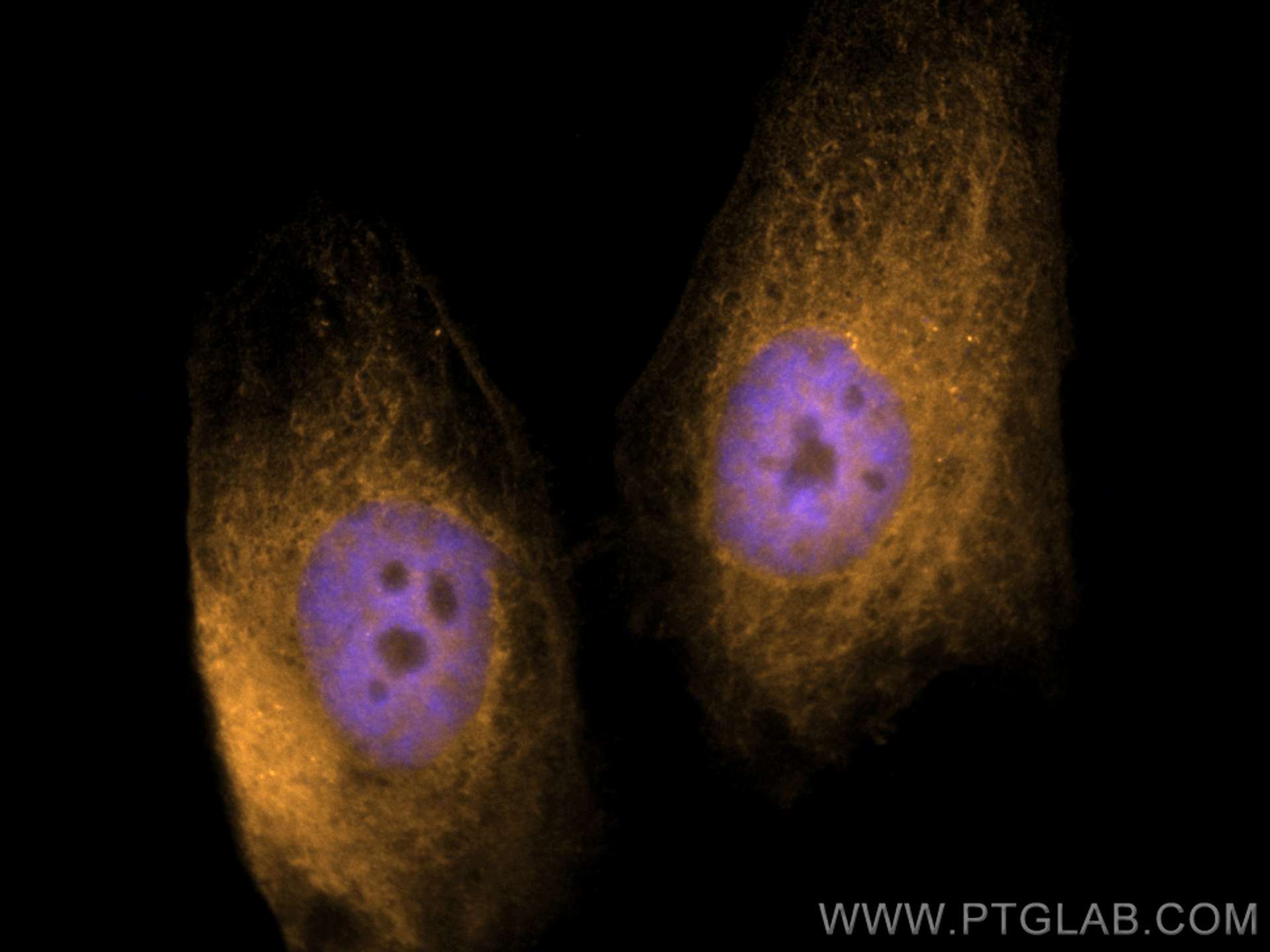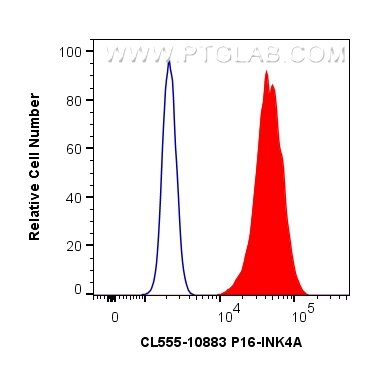- Featured Product
- KD/KO Validated
CDKN2A/P16-INK4A Polyklonaler Antikörper
CDKN2A/P16-INK4A Polyklonal Antikörper für IF/ICC, FC (Intra)
Wirt / Isotyp
Kaninchen / IgG
Getestete Reaktivität
human
Anwendung
IF/ICC, FC (Intra)
Konjugation
CoraLite®555 Fluorescent Dye
Kat-Nr. : CL555-10883
Synonyme
Geprüfte Anwendungen
| Erfolgreiche Detektion in IF/ICC | HeLa-Zellen |
| Erfolgreiche Detektion in FC (Intra) | HeLa-Zellen |
Empfohlene Verdünnung
| Anwendung | Verdünnung |
|---|---|
| Immunfluoreszenz (IF)/ICC | IF/ICC : 1:50-1:500 |
| Durchflusszytometrie (FC) (INTRA) | FC (INTRA) : 0.80 ug per 10^6 cells in a 100 µl suspension |
| It is recommended that this reagent should be titrated in each testing system to obtain optimal results. | |
| Sample-dependent, check data in validation data gallery | |
Veröffentlichte Anwendungen
| IF | See 1 publications below |
Produktinformation
CL555-10883 bindet in IF/ICC, FC (Intra) CDKN2A/P16-INK4A und zeigt Reaktivität mit human
| Getestete Reaktivität | human |
| Wirt / Isotyp | Kaninchen / IgG |
| Klonalität | Polyklonal |
| Typ | Antikörper |
| Immunogen | CDKN2A/P16-INK4A fusion protein Ag1328 |
| Vollständiger Name | cyclin-dependent kinase inhibitor 2A |
| Berechnetes Molekulargewicht | 16 kDa |
| Beobachtetes Molekulargewicht | 16-18 kDa |
| GenBank-Zugangsnummer | BC021998 |
| Gene symbol | CDKN2A |
| Gene ID (NCBI) | 1029 |
| Konjugation | CoraLite®555 Fluorescent Dye |
| Excitation/Emission maxima wavelengths | 557 nm / 570 nm |
| Form | Liquid |
| Reinigungsmethode | Antigen-Affinitätsreinigung |
| Lagerungspuffer | PBS with 50% glycerol, 0.05% Proclin300, 0.5% BSA |
| Lagerungsbedingungen | Bei -20°C lagern. Vor Licht schützen. Nach dem Versand ein Jahr stabil. Aliquotieren ist bei -20oC Lagerung nicht notwendig. 20ul Größen enthalten 0,1% BSA. |
Hintergrundinformationen
Background
p16 is an important cell cycle regulator and acts as a tumor suppressor. It may also be referred to as one of a number of synonyms, including p16INK4a and cyclin-dependent kinase inhibitor 2A.
What is the molecular weight of P16?
16kDa. P16 is encoded by the CDKN2A gene in humans and is a chain comprising 148 amino acids.
What is the function of p16?
P16 inhibits cells from progressing from G1 into S phase, binding to cyclin-dependent kinase 4 (CDK4) and inhibiting its kinase ability, so that it cannot phosphorylate the retinoblastoma tumor suppressor (RB). Without this phosphorylation, RB does not activate downstream genes, so the G1/S checkpoint cannot be passed and the cell does not proliferate (PMID: 8259215).
What is the role of p16 in senescence?
In senescence, cells are irreversibly arrested in the cell cycle. P16 is expressed more highly in aging tissue, is associated with intrinsic cellular aging signals such as telomere shortening, and can therefore be used as a marker of senescence (PMID: 9244355; PMID: 19535234). Due to its role in cell cycle arrest, p16 drives the initiation and maintenance of a cellular senescent phenotype.
What is the role of p16 in cancer?
As a negative regulator of proliferation, p16 is a known tumor suppressor. Mutations in the CDKN2A gene that lead to inactivation of p16 protein have been associated with an increased risk of cancer and are often observed in primary tumors and in cancer cell lines (PMID: 9508208). The inactivation of p16 has been shown to be a key early stage of tumor progression. In a small number of tumor types that are caused by the human papilloma virus (HPV), p16 is in fact overexpressed when RB is inactivated, releasing p16 and causing an accumulation (PMID: 21297668).
Protokolle
| PRODUKTSPEZIFISCHE PROTOKOLLE | |
|---|---|
| IF protocol for CL555 CDKN2A/P16-INK4A antibody CL555-10883 | Protokoll herunterladen |
| STANDARD-PROTOKOLLE | |
|---|---|
| Klicken Sie hier, um unsere Standardprotokolle anzuzeigen |



